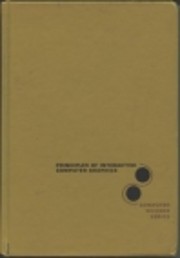

Click on a thumbnail to go to Google Books.
|
Loading... Principles of Interactive Computer Graphicsby William M. Newman
 None No current Talk conversations about this book. no reviews | add a review
Belongs to Series
Covers Many Facets of Computer Graphics & Software Design, Including: Interactive Graphics, Point Plotting & Line Drawing No library descriptions found. |
Current DiscussionsNonePopular covers
 Google Books — Loading... Google Books — Loading...GenresMelvil Decimal System (DDC)001.55Information Computer Science; Knowledge and Systems Knowledge [formerly : Cybernetics & related disciplines] [formerly : Information & communication] [formerly : Communication through records]LC ClassificationRatingAverage: (4) (4)
Is this you?Become a LibraryThing Author. |
||||||||||||||||||||||||||||||||||||||||||||||||||||||||||||||||||||||||||||||||||||||||||||||||||||||||||||||||||||||||
Der er lidt kuk i indholdsfortegnelse og indhold. Fx mangler 27-3 begge steder, men skulle nok være '27.3 A Transformed Display File Model'. 26.2 hedder 27.2 begge steder. (